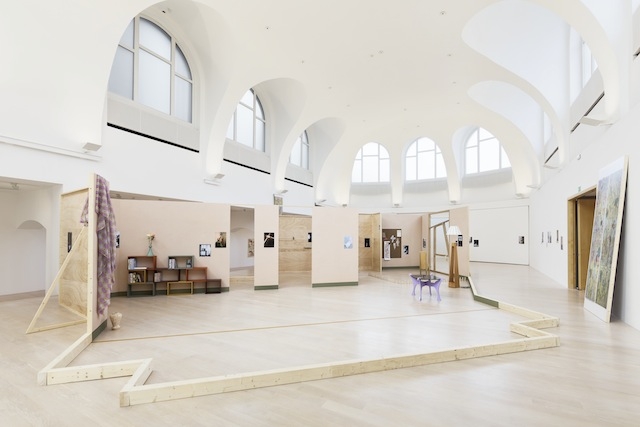Kestner Gesellschaft, Hanover, 29 September – 7 January
Marc Camille Chaimowicz’s exhibition One to One… is a theatre, but one in which each element has been severed and dislocated. The stage is set before we encounter the new installation from which the show takes its title: lining the wall of this first gallery is Rideaux de scène, Théâtre Jean-Vilar, Bourgoin-Jallieu (1991–2) a curtain Chaimowicz made for a French playhouse. In front is a fully proportional dressing room for an imagined (so the exhibition text tells us at least) production of Jean Genet’s The Maids (1947). Installed inside of what looks like a wood shed (and titled The Props and Wardrobe Room, 2011/17) we are nonetheless barred from accessing the space, left to peek through the windows set at myriad curious artefacts and costumes. Not quite true to Genet’s play, however, those who know it will struggle to make sense of the assemblage, suggesting that, in Chaimowicz’s theatre, fabulation extends beyond the stage. Whether experienced before or after the main work here, these two pieces act as a leaking floodgate between public and private, reality and fiction, actor and spectator – a cue to suspend disbelief.
Enter One to One… (2017): a life-sized model of Chaimowicz’s new flat in Vauxhall, London, filling the vaulted hall of the Kestner Gesellschaft, a former bathhouse. Chaimowicz has marshalled his private living space as material for his art practice since the 1970s, so it is not surprising that this (still on-going) home move would spawn an artwork too. His interest in the subjective realm may be read as a protest against Modernism’s proclamation of objectivity, but it is also a convenient outlet for an evident passion for interior design. A comparison with high-postmodernist heavyweights such as Milan’s Memphis Group would not be out of place: Chaimowicz’s aesthetic programme is as sharp as it is playful. Here, a distinct colour palette of earthy pastels adorns walls and textiles, along with solitary furniture pieces such as the exemplary One Metre Chair (1992–3).
But whereas Karl Lagerfeld’s 1980s Monaco penthouse was all Memphis, who would live in all-Chaimowicz other than Chaimowicz himself? His designs possess a remarkable idiosyncrasy and delicate sensitivity wholly antithetical to the gilded irony that otherwise characterises postmodern decor. The single chair and a row of Campari bottles clad with pages from the Financial Times: this is where the display transcends the world of applied arts. For a faint scent of melancholy bruises this home like the resigned loneliness that comes with being the natural sole inhabitant of your own mind. Arranged both within the flat and in the gallery, a series of disorienting photographs by Lise Queinnec shows the London apartment through mirrors or at tilted angles, uncanny and distinctly unpeopled. That Chaimowicz did not take the pictures himself adds another gaze to that of the visitor, the latter already as if illicitly intruding upon someone’s privacy.
Yet this privacy is manifestly staged – like stepping onto a theatre stage after-hours, unsure what show is playing or what your role in it is. An old exhibition flyer pinned to the wall that depicts Chaimowicz lying on a bed with his back turned is the only body represented in the installation. As such, it works as a kind of punctum; a partial presence, or only half-unintentional disclosure of the subject at stake. One to One…, as the title ambiguously implies, is about relationships between entities, be they spaces or people. Two people occupying the same room simultaneously, one in Vauxhall and one in Hanover. This is a thesis on intersubjectivity, intimacy and performance, laid out in beautiful colours.
From the December 2017 issue of ArtReview
